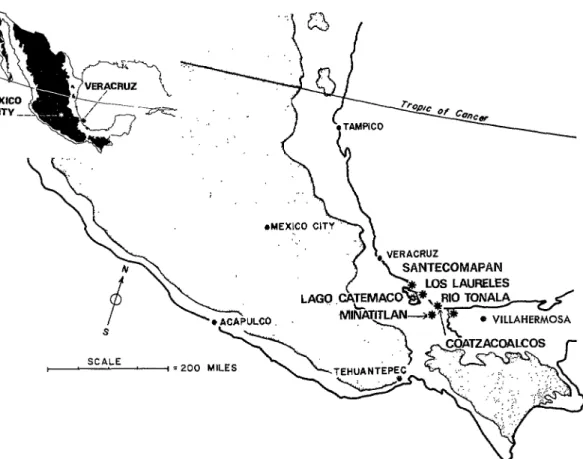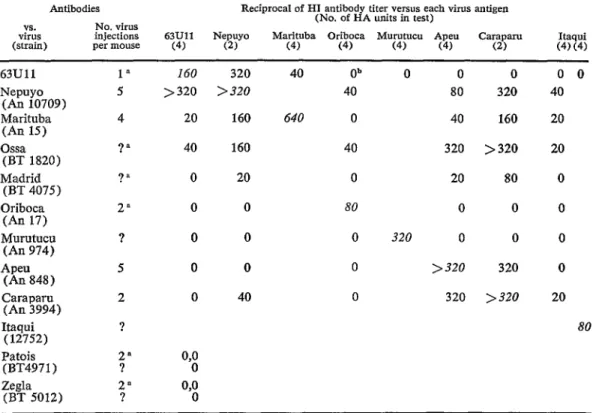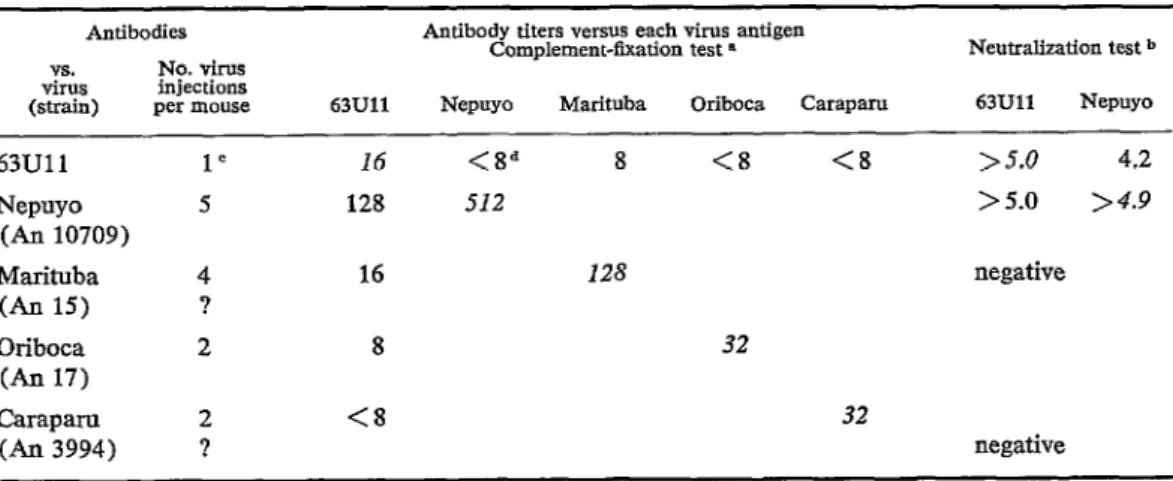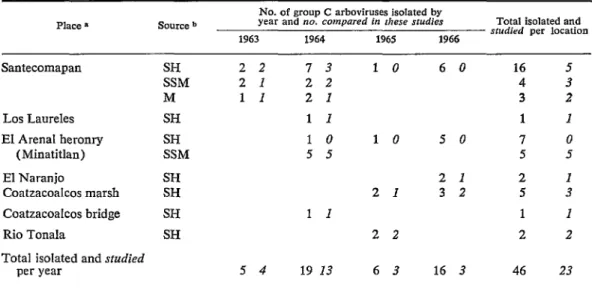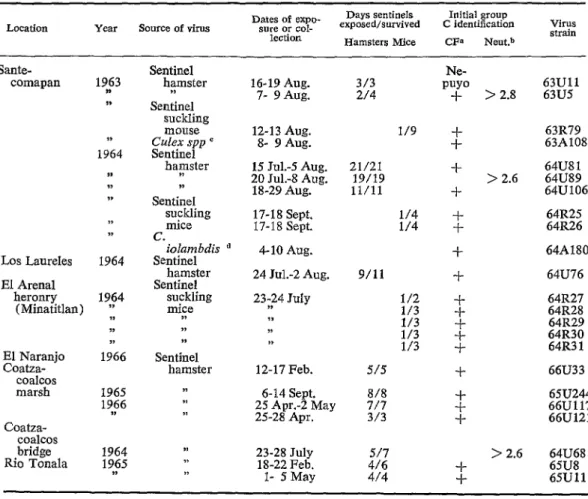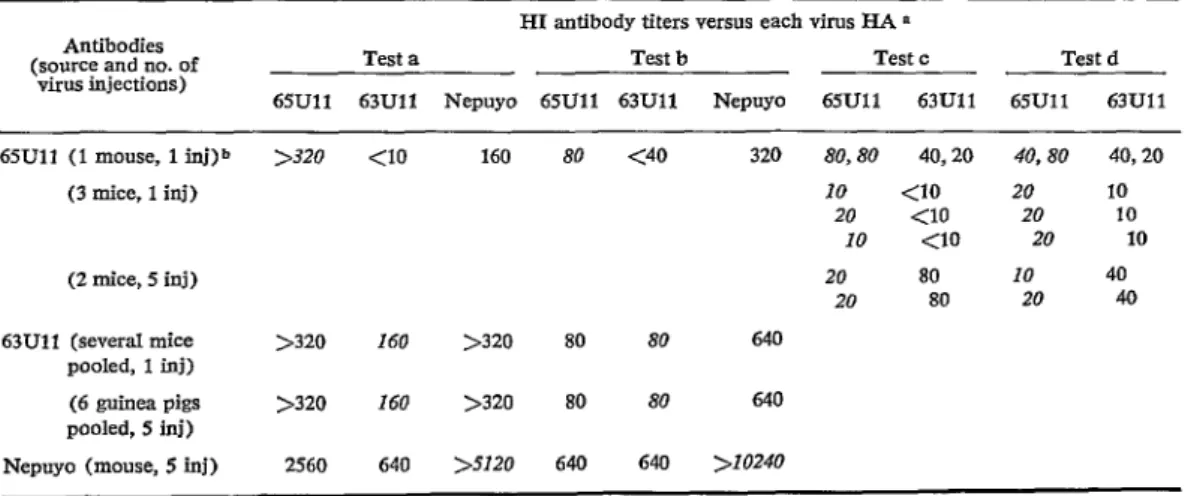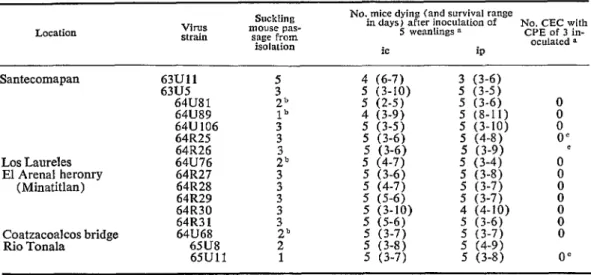DISCOVERY AND IDENTIFICATION OF GROUP C, NEPUYO ARBOVIRUS IN MEXlCOl
Drs. W. F. Scherer,’ M. L. Zarate 3 and R. W. Dickerman’
The discovery of group C, Nepuyo arbovirus in southeastern Mexico during 1963-6ó represents the first group C arbovirus to be isoluted from naturul sources north of Panama, and should alert Mexican physicians to the possibility of related human disease.
Introduction
To date reported isolations of group C arboviruses from natural sources have been limited to the western hemisphere countries of Brazil, Trinidad and Panama (l-3). Since some group C arboviruses are human patho- gens (I), their geographic distribution is of public health importance. This article there- fore describes the discovery and identifica- tion of group C, Nepuyo arbovirus strains isolated from southeastern tropical Mexico during 1963-66.
Ma+erials and me+hods
Study sites were at 7 locations along the Gulf of Mexico coas& 6 in the state of Vera- cruz and 1 in Tabasco (figure 1). 1) Scmte- comapan, Veracruz, a village of approxi- mately 1,000 people, at sea leve1 100 miles southeast of Veracruz City, bordered a brackish water lagoon in a narrow strip of 1 These investigations were performed in collabora- tion with the Pan Ameritan Health Organization and the Government of the United States of Mexico; they were supported in part by USPHS Training Grant 5-Tl-AI-231 and Research Grant AI-06248 from the NTAID and in part by research contract No. DA-149- 193-MD-2295 from the U.S. Army Medical Research and Development Command, Department of the Army, under sponsorship of the Commission on Viral Infec- tions, Armed Forces Epidemiological Board.
ZProfessor and Chairman, Department of Micro- biology, Cornell University Medical College.
3Tnstltuto Nacional de Virologia de la Secretaria de Salubridad y Asistencia, Mexico, D. F. The appoint- ment of Dra. M. L. Zarate as a USPHS-supported Trainee was made in collaboration with the Govern- ment of the United States of Mexico through the Pan Ameritan Health Organization.
4 Assistant Professor, Department of Microbiology, Cornell University Medical College.
coastal lowland between the Gulf of Mexico and the San Andres mountains, a small range of volcanic peaks surrounding Lake Cate- mato. Habitats there included tropical wet forest dominated by canopy-forming trees, secondary and recently cut forest, mangrove, small patches of trees near houses, cultivated fields, open pastures and yards (figures 2-4). 2) Los Laureles, a small group of thatched houses at the base of the Atlantic slope of the San Andres mountains about 15 miles east of Santecomapan, was at the edge of land being cleared of virgin tropical wet forest (figure 5). 3) The EE ArenaE heron colony was located near a sand and grave1 quarry, El Arenal, about 2 miles west of the large oil refining City of Minatitlan (72,000 inhabitants in 1967). This was in a per- manently flooded swamp with trees 20-60 feet tall, and a dense understory of emergent aquatic vegetation l-6 feet tall (figure 6). 4) El Naranjo was a cluster of about 15 thatched-roof, mud-wattle houses at the edge of the same lowland area as El Arenal, but
about 1 mile farther west from Minatitlan (figures 7-8). 5) Bordered by the coastal dunes, and the Rio Coatzacoalcos, the Coat- zacoalcos Marsh, over 12 miles in diameter, extended the entire distance between Mina- titlan and the port City of Coatzacoalcos
326 BOLETÍN DE LA OFICINA SANITARIA PANAMERICANA - Abril 1969
FIGURE 1-Map of study sita in Mexico.
SCALE l
islands of permanently flooded swamp forest, such as the area utilized in these studies (figure 9). This patch of swamp forest was 0.1-0.2 square miles in area and was located about 3 miles from Minatitlan on the west side of the road to Coatzacoalcos, and ap- proximately 0.5 miles from another heron colony and rookery located within a mile of the Minatitlan airport. 6) Two miles east of the Rio Coatzacaalcos bridge, about 3 miles from Coatzacoalcos City, there was an inter- mittently swampy, second-growth forest, with abundant moisture-adapted palms and per- manently saturated soils (figure 10). 7) On the east side of the Rio Tonala, just into the state of Tabasco and about 2 miles inland from the Gulf of Mexico, sentinel animals
were placed in a tall mangrove forest with a thick undergrowth of shrubs and 6-8 foot
ferns (figure ll). This forest was abolished by cutting between summer 1965 and spring 1966. During 1963-66, locality 1) was the principal study area, localities 3)-5) consti- tuted part of a comparative investigation of arboviruses in areas with and without breed- mg herons, and the other localities were studied only sporadically.
Mosquitoes were collected and identified as described elsewhere (4) except that modi- fied Chamberlain light traps and various styles of traps baited with adult hamsters were also used. Isolations of arboviruses from mosquitoes were made using suckling mice as described elsewhere (4).
Sentinel animals. Suckling Swiss albino mice, l-4 days old, used as virus sentinels
Scherer et al.
-
GROUP C, NEPUYO ARBOVIRUS IN MEXICO3
FIGURES 2-ll-See “Materials and methods” text for identificution and descriptions of study habitats.
328 BOLETÍN DE LA OFICINA SANITARIA PANAMERICANA * Abril 1969
mothers; after return to the mother, they were observed for illness and/or death for lo-14 days. A 10% suspension of brains from ill or dead sentinel mice was made in 1% bovine albumin in Hanks’ solution with penicillin, 1 OO units/ml and streptomycin,
100 micrograms/ml (BA); 0.01 ml of the centrifuged supernatant ( 1 03g, 10 minutes) was inoculated intracranially (ic), and 0.0 1 ml subcutaneously (SC), into 8 suckling mice which were observed for 2 weeks.
Adult golden hamsters were used as sen- tinels (SH) as previously described (5). Dead hamsters were stored on dry ice and tested in New York for virus; some hamsters were autopsied at the field laboratory in Mexico and only heart, lung, kidney or brain frozen in sealed glass ampules on dry ice. A 10% suspension of heart, pooled heart and kidney, pooled heart, lung and kidney, or brain was prepared iu BA, centrifuged at 104g for 1 hour at 5”C, and the supernatant fluid passed through a 450 millimicron Milli- pore filter to eliiinate bacteria before inocu- lation of primary chicken embryonic ce11 cul- tures, 0.1 ml per tube culture, to detect VE virus. When no cytopathic effects (CPE) occurred, aliquots of hamster organ suspen- sions stored in sealed glass ampules at -60°C were inoculated into suckling mice lilce the sentinel mouse brain suspensions described above. A few hamster organ sus- pensions were inoculated in 0.1 ml volume into HeLa ce11 cultures and fluid harvested when CPE occurred after 3-7 days at 37°C.
Cell cultures. Mouse L, human HeLa, primary chicken embryo and hamster kidney ce11 cultures were prepared as previously de- scribed (7-10). L cells were maintained in 10% newborn, precolostrum, calf serum in maintenance solution (MS) (7)) HeLa cells in 10% human serum in MS, chicken embryo cells in MS and hamster kidney cells in 2% calf serum in MS. Calf and horse sera were from animals residing in Colorado or the middle eastern coastal states of the USA re-
spectively, and human sera were from resi- dents of Minnesota or New York.
Virus suspensions and infectivity assays. For further studies of a virus, 10% suspen- sions of brain (and sometimes also hind limb muscle) from sick or dead suckling mice were made as described above for brains from sentinel mice and were stored in sealed glass ampules on dry ice or in screw capped vials in an electric -60°C box. In- fectious virus assays were done by ic inocu- lation of suckling mice with decimal dilutions of virus suspension, and 50% lethal doses (SMicLD,,) were calculated (6) in terms of mouse tissue after observation of mice for
2 weeks.
Scherer et al. - GROUP C, NEPUYO ARBOVTRUS IN MEXICO 329
Iation or 6-20 days after the fifth injection of 65Ull virus (given on days 0, 8, 18, 29 and44).
Identification of group C arboviruses was done by complement-fixation (CF) tcst (II ) and for two strains, by neutralization (N) of vira1 CPE in HeLa ce11 cultures using 63Ull guinea pig antiserum. CF antigens were prepnred as supernatant fluids from 20% suckling mouse liver in normal salme, refrigerated at 5°C for 18 hours and cen- trifuged at 1O’g for 60 minutes.
Other procedures employed to character- ize strain 63Ull virus are described else- where as follows: sensitivity of vira1 infec- tivity to sodium deoxycholate (12), N tests in suckling mice (4), preparation of hemag- glutinating (HA) antigens and performance of hemagglutination-inhibition (HI) tests (13). Some CF and all HI tests were done in microtiter plastic Wells with reduced vol- umes of 0.025 ml antigen, 0.025 ml serum, 0.05 ml complement (2 units) and 0.05 ml sensitized sheep erythrocyte suspension for CF tests, or 0.05 ml of goose erythrocyte suspension for HI tests. Before Wration of infected mouse brain suspension of strain 63Ull virus, the suspension was centrifuged at 104g for 30 minutes at 5°C.
Res&
Discovery
of
group C, Nepuyo arbovirus in Mexico. A virus designated 63Ull was recovered from a sentinel hamster which was exposed on 16 August 1963 in a wire cage about 5 feet above ground in a tropical wet forest at Santecomapan, Veracruz. The ham- ster was dead on 19 August, and following inoculation of a suspension of pooled heart, lung, and kidney tissues into suckling mice on 16 December 1963, mice died within 3 days.Initial identification of 63Ull virus as a group C arbovirus was made by CF test usiug polyvalent arbovirus group A, group
B, Group C, Venezuelan encephalitis and Tlacotalpan virus antisera. The test was positive only with 3 different group C anti- sera. Next, 63Ull CF antigen was tested against antibodies to Bunyamwera and Cali- fornia group viruses, to a Mexican strain of Patois virus (63A49), and to group C viruses; positive reactions were again ob- tained only with polyvalent group C anti- serum.s Subsequently 63Ull CF antigen was found to react with individual group C, Caraparu, Marituba and Murutucu antisera, but not with Oriboca, Itaqui or Apeu anti- bodies. Polyvalent group C, Caraparu, Mari- tuba and Murutucu antisera also inhibited 63Ull HA whereas Oriboca, Itaqui, Apeu and polyvalent California group antisera did not. Polyvalent group C serum also neu- tralized 63Ull virus in HeLa ce11 cultures. In contrast Marituba, Murutucu, and Cara- paru antisera failed to neutraliie 63Ull virus in HeLa cell cultures. Thus it seemed that 63Ull virus was a group C arbovirus anti- genically distinct from Oriboca, Itaqui, and Apeu and probably diierent from Caraparu, Marituba, and Murutucu since although it reacted by CF and HA tests with antisera to the latter 3 viruses, it was not neutralized by these antisera.
330 BOLETÍN DE LA OFICINA SANITARIA PANAMERICANA - Abril 1969
and Zegla viruses (table 1) .g The HI rela- tionship between 63Ull virus and Nepuyo virus was such that both antisera strongly inhibited both hemagglutinins. CF tests did not clearly distinguish 63Ull virus from Nepuyo, Marituba and Oriboca, but N tests established its essential identity with Nepuyo virus (table 2).
Filtration, host range, sensitivity to sodium deoxycholate and antigenic properties
of
the OThrough the kindness of Drs. Robert Sbope, W. Downs and others at the Yale Arbovirus Unit and WHO World Arbovirus Referente Center, the studies of 63Ull virus involving infectious antigens of other than the Mexican group C viruses were performed by Dr. Zarate in the Yale laboratory of Dr. Shope who generously supplied the known group C virus antigens and antisera. This was done to avoid working whh known group C viruses in the Cornelj laboratory where there had been none except Oriboca virus prior to re- covery of 63Ull virus, and Oriboca virus was used only as a CF antigen (made in 1961 at the University of Minnesota) in the initial tests described in the text to identify 63Ull virus as a group C virus.63UI I strain of Nepuyo virus. At SM-p7 infectious virus passed 450, 100 and 50, but not 10 millimicron Millipore cellulose Glters; SMicLD,, titers per 0.01 ml of brain for each filtrate were: 450mp-10-6.7, lOOmp-
1 O-6.6, 50mp- 1 O-5.8 and 1 Omr- < 1 O-2.8. 63Ull virus was lethal for suckling mice within 3-4 days of ic inoculation; titers of virus were 10-5.3 SMicLDJO.01 ml of pooled mouse brain and muscle tissues at SM-p2 (average of 3 titrations), and lo-a4 and 1O-s.2 SMicLD.JO.01 ml of liver at SM-p6 and 11 respectively. Weanling mice died within 6-10 days after ic inoculation of > 103.2 SMicLD,, of virus at SM-pl. AduEt mice did not become ill after 2 monthly ip inoculations of 10% infected suckling mouse brain suspension at SM-p3, but made CF and HI antibodies. Three of 3 hamsters over
TABLE 1-lmmunologic relationships between 63Ull virus and grovp C arboviruses by hemagglutination-inhibition test.
Antibodies Reciprocal of HI antibody titer versus each virus antigen
VS. No. virus (No. of HA units in test)
virus injections 63Ull
(4)
Marltuba Oribza Mufi;lucu Apeu Itaqui
(strahl) per mouse (4) (4) (4) (4)
63Ull Nepuyo
(An 10709)
Marituba (An 15)
Osa
(BT 1820) Madrid
(BT 4075) Oriboca
(An 17) Murutucu (An 974) Apeu
(An 848)
Caraparu (An 3994)
Itaqui (12752) Patois
(BT4971) Zegla
(BT 5012)
1” 160 320 40 Ob 0 0
5 >320 >320 40 80
4 20 160 640 0 40
?” 40 160 40 320
?” 0 20 0 20
2” 0 0 80 0
? 0 0 0 320 0
5 0 0 0 >320
2 0 40 0 320
?
2” w
? 0
2” 030
? 0
0 320 160 > 320 80
0 0
0 0
320 0
>320 20
0 0
40 20 20 0
80
Scherer et al. - GROUP C, NEPUYO ARBOVIRUS IN MEXICO 331
TABLE Il-lmmvnologic relationships befween 63Ull virus and group C arboviruses by complement-fixotion and
neutraliration tests. Antibodies VS. No. virus virus injections (strain) per mouse
Antibody titers versus each virus antigen
Complement-íixation test n Neutralization test b 63Ull Nepuyo Marituba Oriboca Caraparo 63Ull Nepuyo
63Ull 1’
Nepuyo 5
(AIl 10709)
Marituba 4
(An 15) ?
Oriboca 2
(An 17)
Caraparu 2
(h3994) ?
16 128
16
8
<8
<Sd 512
8
128
<8
32
<8
32
>5.0 4.2 > 5.0 >4.9
negative
negative
a Reciprocal of serom dilution reacting with 4 CF anügen units except for Nepuyo antigen which was 1 unit. b Loglo neutralization index in suckling mice inoculated ic or negative neutralizarion in HeLa ce11 cultures as described in text.
e Mouse ascitic fluid induced by sarcoma lSO/TG celIs or mouse sermn. 63Ull antibody was from Comell, Mari- tuba and Caraparu with ? injections mere from Dr. J. Casals and the others werc from Dr. R. Shope at Yale.
d Titer 16 VS 16 units of Nepuyo antigen.
332 BOLETfN DE LA OFICINA SANTTARTA PANAMERTCANA . AbrÍE 1969
dium, and no CPE occurred with the smallcst antibody, though antibody titers were slightly
virus dose. higher with 4 units of serum-HA than with
63Ull virus was not dangerous to labo- ratory personnel, provided aseptic technic was empIoyed, nor did human infections occur during field work. No inapparent in- fections were detected by CF test of sera from a) 4 persons who worked with the virus in the laboratory for 1X-2 years, b) 3 per- sons exposed in endemic Mexican habitats during 2-3 month periods during 1963-66, or c) 10 persons exposed in endemic areas during one of the summers of 1963-66.
63Ull virus from SM-p2 was inactivated by sodium deoxycholate in BA, but not by SDC in human serum (1: 1000 final concen- tration of SDC, 37”C, 1 hour). SMicLDJ 0.01 ml of brain representing SM-p2 were: human serum control lo+.“; SDC 1: 1000 in BA, < 10-3.“; and SDC 1: 1000 ín human serum, 10-3.s.
4 únits of liver-HA. Hemagglutinins have also been prepared similarly from serum of adult hamsters.
and serum HA were inhibited by 63Ull CF antigens of 63Ull virus could be made by sucrose-acetone extraction of suck- ting mouse brain, serum or Iiver. Antigen titers at SM-p3 were two- to four-fold higher in liver than in brain, and were equal to four- fold higher in brain than in serum. Liver extracted in saline overnight as a 20% sus- pension and then centrifuged at 104g for 60 minutes at 5°C also provided high titer
(1: 128-512) CF antigens at SM-p3 and at severa1 succeeding mouse passage levels.
Goose erythrocyte agglutinins (HA) could not be made by sucrose-acetone extraction of infected brain, liver or serum at SM-p3. At SM-PS, serum yielded HA of low (1: 8) titer. Additional, rapid serial passages in suckling mice of virus as infected liver sus- pensions eventually, by passages 10 or more, produced high enough titers of virus in serum and liver to produce usable HA by the sucrose-acetone extraction method. HA with titers usually less than 1:128 were obtained from liver or serum 24-32 hours after inocu- lation of mice when tested at the optima1 pH of 6.0 and at room temperature. Both liver
Isolation and nntigenic analysis
uf
22 ad- ditional group C arboviruses from Mexico. Forty-six additional viruses were identitied as group C arboviruses by positive reactions ín CF tests of 1:4-32 dilutions of Iiver anti- gens versus 4-X units of 63U ll virus guinea pig antibody or in neutralization tests in mice or HeLa cell cultures using 63Ull guinea pig antiserum (table 3). Thirteen of these viruses carne from sentinel adult hamsters which were exposed in nature for 2-21 days (mean 7.8 days), and survived a total, in- cluding exposure, of 3-21 days (mean 8.4 days) before becoming ill or dying of virus infections (table 4). Eight strains were from sentinel suckling mice which were exposed overnight without mothers and survived 2-9 days (mean 3.9 days) (table 4). Two virus strains were recovered from Culex mosqui- toes collected in August 1963 and 1964 (table 4); a third strain (table 3) carne from 13 female Culex opisthopus collected in August 1964 from a hamster-baited trap where virus feedback was considered to be unlikely.__- __-_~ -
Scherer et al. * GROUP C, NEPUYO ARBOVIRUS IN MEXTCO 333
TABLE 3-Group C orboviruses from vorious habitots in southeastern Mexico, 1963-1966.
No. of group C arboviruses isolated by
Place = Source b year and no. compred in rhese srudies srudird per location Total isolated and
1963 1964 1965 1966
Santecomapan SH 2 2 7 3 1 0 6 0 16 5
SSM 2 1 2 2 4 3
M 1 I 2 I 3 2
Los Laureles SH 1 1 1 1
El Arenal heronry SH 1 0 1 0 5 0 7 0
(Minatitlan) SSM 5 5 5 5
El Naranjo SH 2 1 2 1
Coatzacoalcos marsh SH 2 I 3 2 5 3
Coatzacoalcos bridge SH 1 1 1 1
Rio Tonala SH 2 2 2 2
Total isolated and sfudied
per year 5 4 19 13 6 3 16 3 46 23
a Rio fonala is in Tabasco State: other locations are in Veracruz State.
b SH = sentinel adult hamster, SSM = sendnel suckling mice, M = adult female mosquitoes.
trol purposes, 23 antisera were tested with Venezuelan encephalitis virus HA and found not to react (table 5, part B). Further HI tests revealed that the results with 65Ull virus were peculiar to one immune mouse ascitic fluid and that other fluids from the same mouse as well as 2 additional hyper- immune fluids reacted with 63Ull HA (table 6). Moreover 65Ull virus was indis- tinguishable from prototype Nepuyo virus (Belem, Brazil strain An10709) by HI test (table 6)) and all 3 viruses were indistin- guishable by N tests although, CF test again did not clearly differentiate the Mexican Nepuyo virus strains from Marituba and Oriboca (table 7). Thus it seemed that the 22 selected group C arboviruses were suffi- ciently similar antigenically to the Mexican 63Ull strain of Nepuyo virus to consider them Nepuyo virus strains.
Pathogenicities of 22 Mexican group C, Nepuyo arboviruses for weanling mice and chicken embryonic cells in culture (CEC). Sixteen strains of virus were inoculated ic and ip into weanling mice and 12 into CEC with fluid medium; al1 killed mice by both routes within 2-11 days of inoculation, and
none produced cytopathic effects in CEC (table 8).
Discussion
Group C arboviruses are known to cause sporadic, systemic disease in man, but to date their geographic distribution as evi- denced by virus isolations has been limited to equatorial regions of the western hemis- phere. The discovery of Nepuyo virus in Mexico initially in 1963 represents the first evidente of group C arboviruses north of Panama, and extends the geographic distri- bution of Nepuyo virus from its previous known locations in Trinidad, Brazil and Panama (2, 3, 14). Its continued presente in Veracruz during 1963-66 indicates that it is endemic there.
334 BOLETÍN DE LA OFICINA SANITARIA PANAMERICANA * Abril 1969
TABLE 4-Background information for the 23 group C arboviruses compared in these studies.
Location Source of virus Dates af expo- sura or col- lection
Days sentinels Ioitial groop exposed/survived C identiíication
Hamsters Mice CFa Neut.b
Virus strain
Sante- comapan
Los Laureles 1964 El Arenal
heronry
(Minatitlan) 114 II 0 1;66 IELE;anjo coalcos marsh Coatza- coalcos bridge Rio Tonala
19$3 V 1, 1964 ,S II IV 7, I> 1965 19f6 1964 1965 3,
Sentinel hamster M Sentinel
suckling mouse Culex spp ’ Sentinel hapster W Sentinel suckling mice c. iolambdis Sentinel hamster Sentinel suckling mice ,>
>I II Sentinel hamster II 7, ,,
16-19 Aug. 3/3
7- 9 Aug. 214
15 CfuL- Aug. 20 Jul.-8 Aug.
18-29 Aug. 17-18 Sept. 17-18 Sept. d 4-10 Aug.
24 Jul.-2 Aug. 23;24 July
II 3, ,>
12-17 Feb. 515
6-14 Sept. 818
25 Apr.-2 May 717
25-28 Apr. 313
23-28 July 18-22 Feb.
l- 5 May
1/9 21/21 19/19 ll/11 5: 9/11 1/2 1/3 1/3 ::z Ne- PUYO + > 2.8
$ +
> 2.6 f -: 4 + -k -i- i -l- i
517 > 2.6
416
4/4 -l- -l-
5%’
63R79 63A108 64U8 1 64U89 64U106 64R25 64R26 64A180 64U76 64R27 64R28 64R29 64R30 64R3 1 66U33 65U244 66U117 66U121 64U68 65U8 65Ulln + = titer of suckliog mouse liver antigen 2 32 VS 2-4 units of 63Ull guinea pig antibody and < 4 vs 2-8 units of 63A49 (a Mexican strain of Patois virus) guinea pig antibody.
bloglo neutralization index in suckling mice inoculated ic (63U5) or HeLa cell cultures. C 110 females and males from a light trap.
d 33 females from a hamster-baited trap where virus feedback was unlikely. to recover virus and detect serum antibodies
be carried out in humans and domestic and wild animals to establish diagnoses, under- stand the ecology and epidemiology of these viruses and evaluate their health hazard in Mexico and tropical Ameritan countries. Moreover since multiple types of group C arboviruses coexist in Trinidad, Brazil and Panama, it is also important to continue studies in Mexico to learn if group C arbo- viruses other than Nepuyo virus exist there.
Summary
Twenty-three virus strains isolated during 1963-66 from sentinel adult hamsters, sen-
Scherer et al. * GROUP C, NEPUYO ARBOVIRUS IN MEXICO 335
TABLE d-Antigenic refatianships by HI tesf befween Nepuyo virus (Mexican sfrain 63Ull) and 22 addifional group C virases isalated in soufheastern Mexico.
Hemagglutinins (part A) or anti- sera (part B) of 22 virus strains
A
Reciprocals of HI antibody titers
of 63Ul1 antisera VS. indicated HA for tests 1-5 a
1 2 3 4 5
Reciprocals ,f HI antibody titers of indicated virus
antisera VS.
HomHAgou “HT’ HA= VE
63Ull 63U5 63R79 6::;: 64R26 64U76 64R29 64R30 64R3 1 65U8 65Ull 64R28 64R27 64U89 64U106 642368 63A108 64A180 65U244 66U33 6%:;:
4: 80 40 40 160 40
2: 80 2 80 2: iii 20 40
40 80
2:
20
1500
40, 4040, 40 160, 80 160, 80 80, 80 20, 20 80, 80 40, 40 80, 40 X0 20 b 20, 20 40, 40
nt nt nt nt nt nt 40 40 20 40: 40 160, 40 160, 40 80, 40 20, 20 40, 40 20, 40 < lO,< 10
SO 20 20, 20 20, 40 8”: :o 40 40
< 10 < 10 < 10 < 10 < 10 2 :o < 10 2 :: < 10 < 10 GE < 10 < 10 < 10
î 63Ull antisera were mouse ascitic fluid A for tests 1-3, B for test 4 and guinea pig serum for test 5. h nt = not tested.
c Venezuelan encepbalitis virus, strain 63U2.
TABLE ó-lmmunologic relationship by HI fesf between 65Ull virus and Nepuyo viruses, strains An10709 and 63lJll.
Antibodies (source and no. of
virus fnjections)
HI antibody titers versos each virus HA *
Test a Test b Test c Test d
65Ull 63Ull Nepuyo 65Ull 63Ull Nepuyo 65Ull 63Ull 65Ull 63Ull 65Ull (1 mouse, 1 inj)b >320 <10 160 80 <40 320 SO,80 40,20 40,80 40,20
(3 mice, 1 inj) 10 <IO 20 10
20 <lO 20 10 10 <IO 20 10
(2 mice, 5 inj) 20 80 10 40
20 80 20 40
63Ull (several mice >320 Ib0 >320 80 80 640 pooled, 1 inj)
(6 guinea pigs >320 Ib0 >320 80 80 640 pooled, 5 inj)
Nepuyo (mouse, 5 inj) 2560 640 >5120 640 640 >IO240
0 Reciprocal of serum dilution inhibiting 24 HA units for 65Ull and 63Ull and l-2 units for Nepuyo in test a, and 16 units for 65Ull 2-4 for Nepuyo and 4-8 for 63Ull in tesl b.
b Ascitic fluid; from this mouse were taken on day 39 for tests a and b and on days 25 and 30 for the 2 results pre-
336 BOLETfN DE LA OFICINA SANITARIA PANAMERICANA * Abril 1969
TABLE 7-lmmunologic relationship by CF and N fesfs between 65Ull virus and Nepuyo viruses, strains An10709
and 63Ull.
Antibodies Antibody titers versos each virus antigen
VS. VhS
(strain)
No. virus Complement-fixation test * Neutralization test b
injeclions Nepuyo Nepuyo
per mouse 65Ull (An10709) (63Ull)Marituha Oriboca Caraparo 65Ull (An10709) (63Ull)
65Ull Nepuyo
(An10709)
(63Ull) Marituba
(An15)
Oriboca
(h17)
Caraparu (An3994)
1” 16 8 16 8 <8 <8 >4.7 >4.9 4.3
5 128 512 128 >5.7 >4.9 >5.0
1 16 <8” 16 8 <8 <8 >4.0 4.2 >5.0
4 16 16 128
2 8 8 32
2 <8 <8 32
a Reciprocal of serum dilution reactinz with 4 CF antigen units except for Nepuyo, which was 1 unit. bLopt” neutralization index in suckling mice inoculated ic.
cMouse ascitic fluid induced by sarcoma 18O/TC cells or mouse serum. 65Ull and 63Ull antibodies were from Cornell. and the others from Dr. R. Shope at Yale.
d Titer 16 VS 16 units of Nepuyo antigen.
sodium deoxycholate. Sixteen other strains Acknowledgmenl also killed weanling mice after intracutaneous
or intraperitoneal inoculation, and in this The participation of A. Moorhouse, E. Jor- respect, Mexican Nepuyo virus strains were dan, S. Farfan B., A. Hamill, B. Pancake and unlike the original strains from Trinidad and Dr. C. Wong-Chia in these investigations was greatly appreciated. Mosquito studies wcre
Brazil. kindly assisted by A. Diaz Najera, Laboratorio
TABLE B-Pathogenicifies of Mexican group C orbovirus strains for weanling mice inoculated ic and ip and for
primary chicken embryonic cells in culfure.
Location Virus strain mouse pas- sage from Suckling isolation
No. mice dying (and survival range
in days) after inoculation of No. CEC with 5 weanlings a CPE of 3 in- oculatcd a
ic ip
Santecomapan 63Ull 5 4 (6-7) 3 (3-6)
63U5 3 5 (3-5)
64U81 5 g::y 5 (3-6) 0
64U89 f:
64U 106 3 5 ‘(;:;j ; \::g 0
64R25 3 5 (3-6) 5 (4-8) 0’
64R26 5 (3-6) 5 (3-9)
Los Laureles 64U76 211 5 (4-7) 5 (3-4) OC
El Arenal heromy (Minatitlan) 641327 64R28 3
3
: g7; 5 (3-8) i
64R29 5 (5-6) : /::;j
64R30
64133 1 3 : g 5 g:;y t 0
Coatzacoalcos bridge 64U68 2b 5 ;;:;j 5 (3-7) 0
Rio Tonala 65U8 2 5 (4-9)
65Ull 1 5 (3-7) 5 (3-8) 0’
0 Inocula for mice mere 10% suspensions of infected suckling mouse brain (except for 63Ull which was liver), 0.02 ml ic and 0.02 ml ip. and mice were observed for 11 days. Inocula for CEC were 1:2 or 1: 10 dilutions of the same suspensions, 0.1 ml per tube culture containing 0.9 ml of MS: cullures were were kept at 36OC f,>r 6 davs.
b Actually. SM-pl, HeLa-p2, SM-p1 for 64USl and 64U76; HeLa-pl, SM-p1 for 64US9; and CEC-pl, SM-PI, HeLa-pl, SM-p1 for 64U68.
Scherer et al. * GROUP C, NEPUYO ARBOVIRUS IN MEXICO 337
de Entornologia, Instituto de Salubridad y En- al1 support of the program of which this study
fermedades Tropicales, Mexico. The generosity is a part, by Drs. C. Campillo Sainz and J. de
of Dr. Gonzalo Bautista of Puebla, Mexico, Mucha Macias, Instituto Nacional de Virologia
made possible the studies at Los Laureles, Vera- de la Secretaria de Salubridad y Asistencia, cruz. Also gratefully acknowledged is the over- Mexico.
REFERENCES
(I) Casals, J. and Clarke, D. H. In Vira1 and Rickettsial Infections of Man, ed. by Hors-
fall, F. L. and Tamm, I., 4th Ed. Phila-
delphia: J. B. Lippincott Co., 1965, pgs. 659-661.
(2) Spence, L., Anderson, C. R., Aitken, T. H. G. and Downs, W. G. “Nepuyo Virus, a New Group C Agent Isolated in Trinidad and Brazii. 1. Isilation and Properties of the Trinidadian Strain”. Amer J Trou Med 15: 71-74, 1966.
(3) Shope, R. E. and Whitman, L. ‘Nepuyo Virus, a New Group C Agent Tsolated in Trinidad and Brazil. II. Serological Stud- ies”. Amer J Trop Med 15:772-774, 1966. (4) Scherer, W. F., Campillo-Sainz, C., Dicker-
man. R. W.. Diaz Naiera, A.. Madalengoi- tia, j. “Tsoíation of ilacotaipan Virus, a
New Bunyamwera-group Virus from Mexican Mosquitoes”. Amer J Trop Med
16:79-91, 1967.
(5) Scherer, W; F., Dickerman, R. W., Wong- Chia. C.. Ventura. A.. Moorhouse A., Geig&, R., and Di& Nájera, A. “Venezui elan Equine Encephalitis Virus in Vera-
cruz, Mexico. and the Use of Hamsters as Sentinels”. Scicrzce 145: 274-275, 1964. (6) Reed, L. J., and Muench, H. “A Simple
Method of Estimating Fifty Percent End- points”. Amer J Hyg27:49>-497, 1938. (71 Dubbs. D. R. and Scherer. W. F. “Tnaoonrent . ,
Vira¡ Infection of Cells’in vi/ro. 111: Mani- festations of Infection of L Mouse Cells by Japanese Encephalitis Virus”. J Bact 91:2349-2355, 1966.
(8) Scherer, W. F., Syverton, J. T. and Gey, G. 0. “Studies on the Propagation irt vitre of Poliomyelitis Viruses. IV. Viral Multi-
plication in a Stable Strain of Human Malignant Epithelial Cells (Strain HeLa)
Derived from an Epidermoid Carcinoma of the Cervix”. J Exp Med 97:695-710,
1953.
(9) Scherer, W. F. “Inapparent Vira1 Infection
of Cells in vitro. 1. Conversion 0f In-
apparent to Apparent Infection by En- vironmental Alteration of Chicken Em- bryonic CelIs in Cultures Inoculated with Japanese Encephalitis Virus”. Amer J Path 45:393-411, 1964.
(10) Scherer, W. F., Izumi, T., McCown, J., and Hardy, J. L. “Sagiyama Virus II. Some Biologic, Physical, Chemical and Immuno- logic Properties.” Amer J Trop Mcd 11: 269-282, 1962.
(II) Scherer, W. F., and Lewis, N. D. “Immuno- logic Studies of Japanese Encephalitis Virus in Japan. VI. Án Evaluation of the Direct Comolement-Fixation Test for De-
tecting Infection of Swine”. Amer J Vet Res 23: 1157-1163, 1962.
(12) Hardy, J. L., Scherer, W. F. and Carey, J. B., Jr. “Differential Inactivation of Arthropod- Borne Animal Viruses by Bile and Bile Salts in Plasma or Serum”. Amer J Epidem 82:73-84, 1965.
(13) Clarke, D. H., and Casals, J. “Techniques for Hemagglutination and Hemagglutination- Inhibition with Arthropod-Borne Viruses”. Amer J Trop Med 7:561-573, 1958. (14) Srihongse, S., Galindo, P. and Grayson, M.
A. “Isolation of Group C Arboviruses in Panama Including Two New Members, Patois and Zegla”. Amer J Trop Med 15: 379-384, 1966.
Descubrimiento e identificación de Nepuyo Arbovirus, Grupo C, en México (Resumen)
Veintitrés cepas de virus, aisladas durante el de mosquitos o ratones centinelas. Una de las
período 1963-1966, de cricetos centinelas cepas (63Ul l), estudiada detenidamente, pasó
adultos, ratones lactantes centinelas y mosqui- por filtros de 50 milimicrones, pero no de 10
tos Cufex capturados en los estados mexicanos milimicrones; mató ratones lactantes y desteta-
338 BOLBTfN DE LA OFICTNA SANITARIA PANAMERTCANA * Abril 1969
en cultivos de células L de ratón y células Otras 16 cepas también mataron ratones desteta- HeLa humanas y en cultivos primarios de célu- dos después de inoculación intracraneana o las de riñón de criceto, pero no en cultivos intraperitoneal y, a este respecto, las cepas celulares primarios de embrión de pollo. El mexicanas de virus Nepuyo se diferenciaron de virus fue inactivado con deoxicolato sódico. las cepas originales de Trinidad y del Brasil.
Descobrimenio e identificac$o do Grupo C, Nepuyo Arbovirus, no México (Resumo)
Vinte e três famílias de vírus, isolados no intracraniana, e cricetos, mas náo cobaia, após período de 1963-66, de criceto adulto sentinela, inoculac$ío subcutânea. Produziu efeitos cito- de camundongo sentinela em período de páticos em culturas de células L de camun- amamenta@ío e de mosquito Culex captados dongo e de células humanas HeLa e em cul- no Estados de Veracruz e Tabasco, no México, turas primárias de células de rim de criceto, foram identificadas como Grupo C, Nepuyo mas náo em culturas primárias de células de
Arbovirus. Foram isoladas mais famílias de embraiáo de galinha. 0 vírus foi inativado criceto sentinela do que de mosquito ou camun- por deoxicolato de sódio. Dezesseis outras dongo sentinela. Urna família (63Ull) que famílias mataram também camundongos recém- foi estudada minuciosamente atravessou filtros desmamados após inoculacáo intracraniana ou de 50 milimicros mas náo de 10 milimicros, intraperitoneal e, nesse particular, as famílias matou camundongos em período de amamen- do vírus mexicano Nepuyo eram diferentes das ta@o e recém-desmamamdos após inoculacáo famílias originais de Trinidad e do Brasil.
Dépistage et identification de Nepuyo arbovirus, groupe C, au Mexique (Résumé)
Vingt-trois souches virales, isolées pendant la période 1963-1966 à partir de hamsters sentinelles adultes, de souriceaux sentinelles à la mamelle et de moustiques Culex recueillis dans les Etats de Veracruz et de Tabasco (Mexique) ont été identifiées comme apparte- nant à Nepuyo arbovirus, groupe C. On a isolé un plus grand nombre de souches à partir de hamsters sentinelles que de moustiques ou de souris sentinelles. Une des souches (63Ull), étudiée en détail, a traversé des filtres de 50 millimicrons mais non des filtres de 10 milli- microns; elle a tué les souriceaux à la mamelle et les souriceaux sevrés, après inoculation intra- cranienne, ainsi que les hamsters, mais non les
cobayes, après inoculation sous-cutanés. Elle a produit des effets cytopathiques dans les cultures cellulaires L de la souris, les cellules HeLa humaines et les cultures cellulaires pri- maires de rein de hamster, mais non dans es cultures cellulaires primaires d’embryon de poulet.
Le virus a été rendu inactif avec du désoxy- cholate de sodium. Seize autres souches ont également tué des souriceaux sevrés, après inoculation intracranienne ou intrapéritonéale, et, à cet égard, les souches virales mexicaines Nepuyo étaient dissemblables des souches originales de la Trinité et du Brésil.
ANTICUERPOS SINTÉTICOS
“Grande es, sin duda, el porvenir de la inmunología. Siendo así que nos es perfectamente conocida la estructura molecular de los anticuerpos naturales, con sus cuatro cadenas, la hilación en serie de sus aminoácidos, etc., pronto podremos estar en condiciones de fabricar anticuerpos artificiales. Y estos anticuerpos, obra de la bioquímica al servicio del hombre, no irán acompañados de las reacciones y alergias que siguen siendo características de los sueros actuales.”
